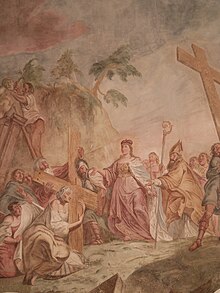Schambach (Kipfenberg)
The parish village of Schambach is a district of the Kipfenberg market in the central Schambach valley in the Eichstätt district .
geography
The place with its approx. 65 inhabitants extends as a street village shortly before the source of the Schambach in the so-called middle or Arnsberger Schambachtal on the district road EI 10 from Arnsberg to Böhmfeld . From the Altmühltal you turn into the Arnsberg district of Schambachtal and after about three kilometers, shortly after the Lohmühle, you reach the village of Schambach (389 m above sea level).
history
There is evidence of a settlement from the Roman Empire at Schambach underground. The place is first mentioned in a document in 945 during an exchange of goods. The Eichstatt Bishop Gundekar II consecrated a church in the 11th century. This belonged to the Böhmfeld parish as a branch until 1793 ; In that year the place received its own parish with a branch Attenzell . In 1370 the church set belonged to the Lords of Arnsberg in the Altmühltal . In 1602 the branch was visited by the Eichstätt vicar general Priefer, who found two altars and a copper cross that is said to have been found in a well. In 1726 there was a hermitage at the church. Schambach was incorporated with Attenzell, to which it belonged, on April 1, 1971 to Kipfenberg.
To the north-northwest in the “Brand” corridor area are the remains of the prehistoric section fortification Brand .
Attractions
Today's pilgrimage church Heilig Kreuz is a new baroque building, built in 1755/56 and equipped until 1770.
At the church there is a cemetery chapel from the 16th / 17th centuries. Century. The neighboring rectory was built in 1793.
In 1724 the St. Helena chapel was built over a nearby spring near the Lohmühle. According to legend, the Romanesque copper cross with the cross particle set in the baroque reliquary is said to have been found at this point in the water on this "fountain of grace". The water is considered to be beneficial for eye ailments.
Natural monuments
South of Schambach one still gets in the Schambach for " beaver platform ," one of the Bund Naturschutz in Bavaria built wooden platform to observe the animals of the local beaver lodge.
After the Schambach springs, the Katzental continues the Schambach valley as a dry valley . At the beginning of it you will find the 35 meter long ice age cave Hohler Stein . The Katzental is characterized by poor grasslands , which are among the most species-rich communities and provide a habitat for a large number of endangered and rare animal and plant species.
literature
- Helmut Flachenecker : About everyday suffering in a rural region. The Holy Cross pilgrimage to Schambach in the 18th century. In: Alexandra Kohlberger (Hrsg.): Kulturgeschichten. Festschrift for Walter Pötzl on the occasion of his 60th birthday (= 26th annual report of the Heimatverein for the Augsburg district 1997–99). Volume 1, Augsburg 1999, pp. 437-457.
- Georg Dehio : Handbook of the German art monuments . Bayern IV. Munich / Berlin 2006, p. 1164.
- Catholic Church Foundation Schambach (Ed.): Pilgrimage Heilig Kreuz Schambach / Kipfenberg. Nürnberg / Amberg 2007. (with further references)
Web links
- Building description and photo of the church
- Bells ringing and photos of the church
- Katzental
- Legend of the fountain of grace
Coordinates: 48 ° 54 ' N , 11 ° 22' E




